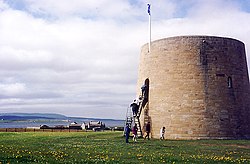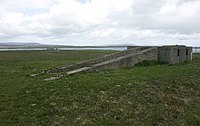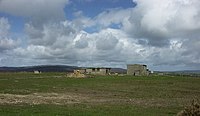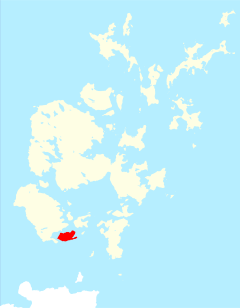South Walls: Difference between revisions
Created page with '{{Infobox island |name=South Walls |norse=Vágaland / Vágar |county=Orkney |picture= |picture caption= |map= |os grid ref=ND304895 |area=4¼ square miles |summit=187 feet |popul…' |
mNo edit summary |
||
| Line 3: | Line 3: | ||
|norse=Vágaland / Vágar | |norse=Vágaland / Vágar | ||
|county=Orkney | |county=Orkney | ||
|picture= | |picture=Hacknessmartello.jpg | ||
|picture caption= | |picture caption=Hackness martello tower (1814) | ||
|map= | |map=South Walls Orkney.svg | ||
|os grid ref=ND304895 | |os grid ref=ND304895 | ||
|area=4¼ square miles | |area=4¼ square miles | ||
| Line 24: | Line 24: | ||
==History== | ==History== | ||
[[File:Southwallsradar.jpg|right|thumb|200px|Radar platform on South Walls near Wyng]] | [[File:Southwallsradar.jpg|right|thumb|200px|Radar platform on South Walls near Wyng]] | ||
[[File:Southwallswireless.jpg|right|thumb|200px|Gallow Tuag Royal Navy Wireless Station]] | [[File:Southwallswireless.jpg|right|thumb|200px|Gallow Tuag Royal Navy Wireless Station]] | ||
Revision as of 07:55, 1 September 2012
| South Walls | |
 Hackness martello tower (1814) | |
|---|---|
| Main village: | Longhope |
| Location | |
| Grid reference: | ND304895 |
| Area: | 4¼ square miles |
| Highest point: | 187 feet |
| Data | |
| Population: | 120 |
South Walls is an inhabited island adjacent to Hoy in Orkney, jined to Hoy by a causeway. The island’s name is a corruption of "Sooth Was", which means the "southern voes" (inlets).
South Walls forms the southern side of the harbour of Longhope. It was a tidal island until a narrow causeway, was constructed over the sandbank, which was known as the Ayre, although this name has become transferred to the causeway itself.[1] Although sometimes considered to be a peninsula, it is an island in all but name.
South Walls is a popular stopping off place for barnacle geese.
Geography and geology
The island, like most of the Orkney archipelago, is made up of old red sandstone with the Rousay Flagstone Group predominating.[2]
The island is more or less oval in shape, but there is a small promontory, called Cantick Head in the south east, which is created by Kirk Hope (Church Bay). It is separated from Hoy by an arm of the sea, also called Longhope. The area to the south of the causeway is known as Aith Hope.
History


Norse period
South Walls features fairly prominently in the Norse period, partly because it was the first landfall when sailing from west Caithness or Sutherland. The Orkneyinga saga mentions the island several times, such as in Chapter XCV:
Early in the winter, Earl Erlend [Harald's Son] and Swein left Thurso, and took their course by the west coast of Scotland. They had six long-ships, all well manned. They had to row, and when they had gone some distance from Caithness, Earl Rögnvald]]'s spies went out to the islands, and told him the news. Then the Earls moved their ships to Scapa, and Earl Rögnvald wished them to stay a while on board. When Swein and Erlend came west off Stour ["Ru Stoer in Assynt on the west coast of Sutherland"], the former said that they should not distress themselves by rowing any further, and asked his men to put the ships about and set the sails. This action on the part of Swein was thought foolish, yet his men did as he desired them, when they had been sailing for a while the ships began to speed, because there was a fine breeze, and nothing is said of their voyage until they reached ‘’Vagaland’’ [South Walls] in Orkney. There they heard the Earls were lying at Scapa, off Knarston with thirteen ships... It was four nights before Simon's-mas when Swein, Asleif's Son decided to attack the earls during the night, but it was thought rather hazardous, as their followers were so much more numerous. Yet Swein insisted on having his own way, and so he did, because the Earl wished to follow his advice."[3]
South Walls also played a crucial role in the Christianisation of Orkney. Christianity in the islands was wiped out by the Norse settlement, until Olaf I King of Norway (Olaf Tryggvasson) forced the Earl of Orkney, Sigurd Hloðvisson to be baptised at South Walls.[1] Earl Sigurd accepted, and remained a nominal Christian the rest of his life. However, he did so under duress and King Olaf had many Völva|valas (Norse shamans) executed by being tied and left on a skerry at ebb.
Modern history
Overlooking Longhope in the north east is Hackness Martello Tower and Battery.[4] The tower, together with another on the north side at Crockness, was built in 1815 to protect British ships in the bay of Longhope against attack by American and French privateers, during the Napoleonic Wars, while they waited for a Royal Navy escort on their journey to Baltic ports.[5] The towers were rearmed for First World War. There is a similar tower across the Bay in South East Hoy. Hackness Martello Tower and Battery is in the care of Historic Scotland.
Cantick Head is well known for its lighthouse designed and built by David and Thomas Stevenson and first lit in July 1858 and automated in 1991.[6]
South Walls has substantial remains from the Second World War, when Scapa Flow was used as a Royal Navy base.
Nature reserve
The Hill of White Hamars hill farm is a Scottish Wildlife Trust nature reserve.
References
- ↑ 1.0 1.1 Haswell-Smith, Hamish. (2004) The Scottish Islands. Edinburgh. Canongate.
- ↑ Brown, John Flett "Geology and Landscape" in Omand (2003) p.4.
- ↑ Anderson, Joseph (Ed.) (1893) Orkneyinga Saga. Translated by Jón A. Hjaltalin & Gilbert Goudie. Edinburgh. James Thin and Mercat Press (1990 reprint). ISBN 0-901824-25-9
- ↑ "Hackness Martello Tower" Undiscovered Scotland. Retrieved 15 November 2008.
- ↑ "Travel Scotland: Hoy". http://www.scotland.org.uk/guide/Hoy. Retrieved 2007-07-13.
- ↑ "Cantick Head Lighthouse." Northern Lighthouse Board. Retrieved 15 November 2008.
- Omand, Donald (ed.) (2003) The Orkney Book. Edinburgh. Birlinn. ISBN 1-84158-254-9
- Haswell-Smith, Hamish (2004). The Scottish Islands. Edinburgh: Canongate. ISBN 1841954543.
| Islands of Orkney |
|---|
|
Inhabited islands: |
